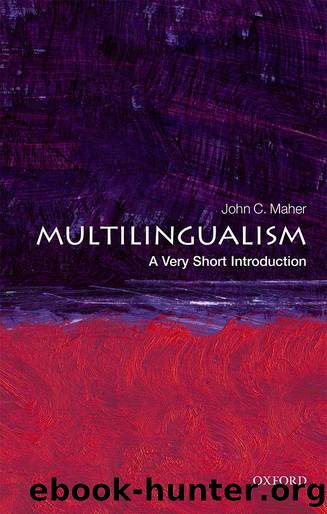Multilingualism by John C. Maher

Author:John C. Maher [Maher, John C.]
Language: eng
Format: epub
ISBN: 9780191038075
Publisher: Oxford University Press
Published: 2017-02-27T00:00:00+00:00
Multilingualism in the family
The Meng family migrated to Philadelphia from Cambodia. The children use Khmer at home, some Chinese when Skyping grandparents in Phnom Penh, and English at school. The youngest child, unlike the eldest child, learned to speak Khmer in America and hardly speaks Chinese. His mother fears for her fluency and interest in Khmer. Such language attrition is referred to as âsubtractive bilingualismâ. There are various ways to understand this language phenomenon. Two concepts are useful: compound and coordinate bilingualism. A person may learn two languages in the same environment and use the same meaning for corresponding words in the same language: two signifiers for one thing signified. Neither language is dominant. This kind of fused representation of two or more languages in the brain is traditionally termed âcompound bilingualismâ. By contrast, a person may learn a language in different communities or contexts. Linguistic expression is kept separate, while the meanings of words may differ in different contexts. This means that for any one word or expression, the child possesses two signifiers and two signifieds.
In addition to French being spoken in their house in Bordeaux, France, Jack speaks German to his children and Adile addresses them in Turkish. Two parallel systems. This is because Jack and Adile have adopted a one person/one language policy (une personne une langue). This is a popular approach adopted by parents to foster simultaneous bilingualism, whereby children are addressed at an early age in two different spoken languages. This is different from âsequential bilingualismâ, where languages are learned one after another.
The theory of une personne une langue was introduced by a student of the Swiss linguist Ferdinand de Saussure (1857â1913) in Paris. Maurice Grammontâs idea, in his Observations sur le langage des enfants (1902), was that the child need not be âtaughtâ anything. It is enough to speak. Select one of the languages and use it so that each language has its own representative. If it is French then the French speaker will speak, if German then the language is symbolized by a German speaker and the roles are also maintained. Roles are not reversed.
Grammont passed on his theory to fellow linguist Jules Ronjat, who was married to a German in Paris. Ronjatâs speciality was Occitan, a language of southern France and Catalonia. Ronjat implemented the âGrammont formulaâ with little Louis and published his careful record and transcription of his sonâs development from birth to 4.10 years.
Louis was born in 1908 at Vienne by the River Rhône in France, and grew up trilingual: fluent French and German with some knowledge of Franco-Provençal (related to Occitan). The experiment was successful, and throughout his later life he adjusted his speech according to his interlocutors. Ronjatâs influential biography was published as Le Développement du Langage observe chez un enfant bilingue (The Development of Language: Observations of a Bilingual Child). The approach has been taken up by generations of parents and children, suggesting that in a multilingual household, by separating languages from the beginning, there might be greater clarity of usage since each language has a different (adult) model.
Download
This site does not store any files on its server. We only index and link to content provided by other sites. Please contact the content providers to delete copyright contents if any and email us, we'll remove relevant links or contents immediately.
| Africa | Americas |
| Arctic & Antarctica | Asia |
| Australia & Oceania | Europe |
| Middle East | Russia |
| United States | World |
| Ancient Civilizations | Military |
| Historical Study & Educational Resources |
Machine Learning at Scale with H2O by Gregory Keys | David Whiting(4183)
Never by Ken Follett(3793)
Fairy Tale by Stephen King(3220)
The Man Who Died Twice by Richard Osman(2997)
Oathbringer (The Stormlight Archive, Book 3) by Brandon Sanderson(2883)
Will by Will Smith(2793)
Rationality by Steven Pinker(2291)
The Dark Hours by Michael Connelly(2243)
Can't Hurt Me: Master Your Mind and Defy the Odds - Clean Edition by David Goggins(2228)
The Dawn of Everything: A New History of Humanity by David Graeber & David Wengrow(2122)
Friends, Lovers, and the Big Terrible Thing by Matthew Perry(2119)
Principles for Dealing With the Changing World Order: Why Nations Succeed and Fail by Ray Dalio(1974)
HBR's 10 Must Reads 2022 by Harvard Business Review(1777)
A Short History of War by Jeremy Black(1762)
Go Tell the Bees That I Am Gone by Diana Gabaldon(1687)
515945210 by Unknown(1599)
A Game of Thrones (The Illustrated Edition) by George R. R. Martin(1589)
Kingdom of Ash by Maas Sarah J(1526)
443319537 by Unknown(1470)
